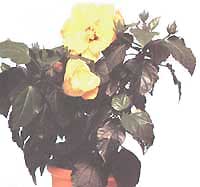Hibiscus (Chinese rose) / hibiscus
Refers to the Malvian family. Fatherland is Southeast Asia.
General description: Usually in the room conditions a species of Hibiscus rosa-sinensis (Hibiscus chinese) is bred. It is a durable bush (it lives more than 20 years) with very beautiful flowers, blooming from spring until autumn. It is large enough (more than 1 m) and spreading, it is usually grown as if a single plant. Flowers with a serrate margin, green or multicolored. The flowers are large, with very thin petals, once again terry, usually red, but there are varieties with snow-white, pink and orange flowers.
Spring is useful for pruning, but in the summer, regular pinching. During flower flowering, it is best not to rearrange the pot and not to turn it in any way.
Breed similar Hibiscus schizopetalus (Hibiscus dissectedlope). This species has drooping tubular flowers with petals cut in the outskirts. The stems are weak, need support.
Recommendations for plant care Hibiscus :
Illumination: Photovoltaic, in the warm season, scattered light is preferred, in the winter direct sunlight is useful, it is better to keep closer to the southern windows.
Irrigation regime : Abundant during the growth period, moderate in winter. To water with warm soft water. He does not adore in any way the overflow, nor the drying out of the earth.
Humidity : Needs regular spraying.
For summer it is better to place on a fresh atmosphere (in a park or on a balcony), in a room protected from wind and from direct sunlight.
Temperature regime: Warm, but not hot, in the summer 20-25 ° C, in the winter 15-20 ° C,
Soil : Recommended soil mishmash: 1 share of sod land, 1 share of leaf land, 1 share of peat, and 1 share of sand.
During the growth period, it needs fertilizing once every three weeks with complex fertilizers for flowering plants.
Breeding : Stem cuttings of hibiscus easily root in late summer.
Transplantation : In the spring, annually. Before transplanting, the plant is shortened.
Roots grow hastily, so hibiscus adores spacious dishes.
Pests : Shields are attacked (brown leaves appear on the leaves and stems, leaving sticky excretions), aphids (they form sticky excretions on shoot tips, buds).
With a slight infection, the plant is allowed to help finish with a soap solution and a warm wash.
In case of severe damage, spraying with an insecticide solution is recommended.

Hibiscus (Chinese rose) - hibiscus


Comments
When commenting on, remember that the content and tone of your message can hurt the feelings of real people, show respect and tolerance to your interlocutors even if you do not share their opinion, your behavior in the conditions of freedom of expression and anonymity provided by the Internet, changes Not only virtual, but also the real world. All comments are hidden from the index, spam is controlled.